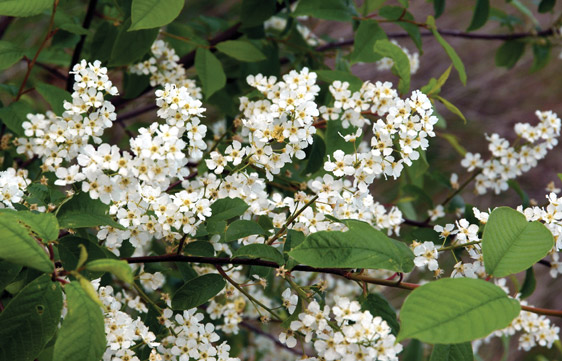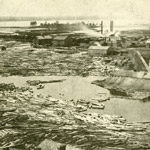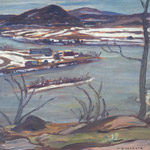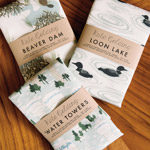
Although our school books clearly delineate one forest region from another, the lines on the ground are blurred.
But they’re all just trees right? That’s more or less what I thought as a callow student learning the forest regions of Ontario. Way up north were the freezing and boggy Hudson’s Bay lowlands, a little further south was the boreal forest – a cold, dark, and endless stand of conifer, then the Great Lakes forest of cottage country pine and maple, and finally, where I lived, the deciduous region, the area that hugs the north shores of Lakes Ontario and Erie.
Luckily we grow up, get a little knowledge under our belts and eventually find ourselves doing things incomprehensible to our youth – bird watching, gardening, and wandering through the woods with a well-thumbed tree identification book. We start to recognize the unique qualities of this place we call home, qualities that go far beyond remembered textbook definitions.
Northumberland, Quinte and Prince Edward County fall within the deciduous forest region in Ontario, an area that borders the southeast shore of Lake Huron and the northern shores of Lake Erie and Lake Ontario. It’s the smallest forest region in Ontario, comprising just three percent of Ontario’s area, of which only one-tenth of this three percent is forest. Further, this small amount of remaining woodland is fragmented by cities, towns, farms, roads and highways, with remaining forests generally located on marginal land. And yet, whether the measure is mammals, birds, plants, insects, reptiles or amphibians, the deciduous forest region is the most biodiverse in the province.
Why is this? A big factor is that we’re a little warmer than the rest of the province thanks to the moderating influence of Lake Ontario and Lake Erie, which retain heat in summer and release it in winter. As any gardener knows, more warmth means more types of plants and species can survive.
WHERE DOES THE CAROLINIAN FOREST FIT IN? More complicated is that, although our school books clearly delineated one forest area from another, the lines on the ground are blurred. If we look to the area of the province south and west of Watershed country – around the western end of Lake Ontario and across the fertile plains north of Lake Erie, from the Rouge River to the southern tip of Lake Huron – we find the influencing factor of the Carolinian forest, at least what’s left of it in Ontario.
The Carolinian forest in Ontario is the northernmost tip of what our American friends call the eastern woodlands, a massive region that extends down to the Carolinas and as far west as parts of Michigan, Ohio and Indiana. In southwest Ontario, the Carolinian forest overlaps parts of the deciduous forest region. Remember I mentioned earlier that this is complicated?
There is staggering diversity of trees within the Carolinian forest, including the fruit-bearing paw paw, the towering tulip tree, sassafras, red mulberry, the cucumber tree, the pignut hickory – distinctly southern-sounding names among more than 70 different tree species, each helping support distinct plant and animal communities. Consider that southern Vancouver Island, another Canadian biodiversity hot spot, has perhaps 20 native tree species, and you’ll have some idea how important the Carolinian zone is.
Technically, Quinte, Northumberland and Prince Edward Counties aren’t part of the Carolinian forest but quite a few Carolinian species have worked their way beyond their defined geographic area into Watershed country. You won’t see all of those 70 species, but there are more than a few that will be familiar: the bitternut hickory, black walnut, black maple, black oak, basswood, and black cherry. Keep your eyes open and you might even spot a blue beech, or ‘musclewood tree’ so-named for the appearance of its trunk and limbs. The list of Carolinian species can also, sadly, remind us of what’s been lost. Gone is the magnificent American chestnut, which comprised about one-quarter of the eastern woodlands forest before it was wiped out by a chestnut blight introduced from Asia in the early 1900s. Almost gone is the butternut, once a relatively common tree in our area, which has its existence threatened by yet another introduced blight.
The Carolinian forest is also associated with some of the province’s remaining tallgrass prairie, a globally rare ecosystem found in a number of Watershed area locations, including Alderville and the Red Cloud Cemetery south of Rice Lake, along with recently restored areas in the Ganaraska Forest. Indicator plant species common to both the Carolinian and local sites include big bluestem grass and butterfly milkweed. Fauna of both areas include the southern flying squirrel – although you’ll be very lucky to see one – and the eastern hog-nosed snake, well-known for a defence mechanism that begins with rearing up like a cobra, and then playing dead.
Is it possible to plant Carolinian forest species in Watershed country? We’re too cold for many of the truly southern species, but if your property has a warm and protected south-facing site, you might get away with planting a tulip tree or sycamore; you won’t be the first. Your local nursery may have other suggestions for Carolinian trees to try. Hardcore ecologists might not agree with bringing a species so far out of its niche, but you’ll have a nice conversation starter with the gardeners in your neighbourhood and a daily reminder of the diversity to be found in our deciduous forest region.
For more information on the Carolinian forest characteristics, visit: caroliniancanada.ca
Story by:
Norm Wagenaar




